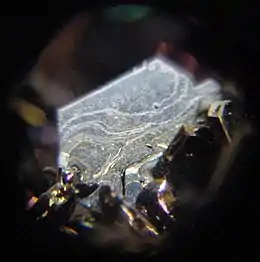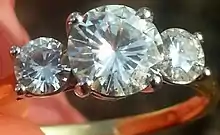Moissanite
Moissanite /ˈmɔɪsənaɪt/[4] is naturally occurring silicon carbide and its various crystalline polymorphs. It has the chemical formula SiC and is a rare mineral, discovered by the French chemist Henri Moissan in 1893. Silicon carbide is useful for commercial and industrial applications due to its hardness, optical properties and thermal conductivity.
| Moissanite | |
|---|---|
 | |
| General | |
| Category | Mineral species |
| Formula (repeating unit) | SiC |
| Strunz classification | 1.DA.05 |
| Crystal system | 6H polytype, most common: hexagonal |
| Crystal class | 6H polytype: dihexagonal pyramidal (6mm) H-M symbol: (6mm) |
| Space group | 6H polytype: P63mc |
| Identification | |
| Color | Colorless, green, yellow |
| Crystal habit | Generally found as inclusions in other minerals |
| Cleavage | (0001) indistinct |
| Fracture | Conchoidal – fractures developed in brittle materials characterized by smoothly curving surfaces, e.g., quartz |
| Mohs scale hardness | 9.25 |
| Luster | Adamantine to metallic |
| Streak | greenish gray |
| Diaphaneity | transparent |
| Specific gravity | 3.218–3.22 |
| Refractive index | nω=2.654 nε=2.967, Birefringence 0.313 (6H form) |
| Ultraviolet fluorescence | orange-red |
| Melting point | 2730 °C (decomposes) |
| Solubility | none |
| Other characteristics | Not radioactive, non-magnetic |
| References | [1][2][3] |
Background
Mineral moissanite was discovered by Henri Moissan while examining rock samples from a meteor crater located in Canyon Diablo, Arizona, in 1893. At first, he mistakenly identified the crystals as diamonds, but in 1904 he identified the crystals as silicon carbide.[5][6] Artificial silicon carbide had been synthesized in the lab by Edward G. Acheson just two years before Moissan's discovery.[7]
The mineral form of silicon carbide was named moissanite in honor of Moissan later on in his life. The discovery in the Canyon Diablo meteorite and other places was challenged for a long time as carborundum contamination from man-made abrasive tools.[8]
Geological occurrence
Until the 1950s, no other source for moissanite than meteorites had been encountered. Then, in 1958, moissanite was found in the Green River Formation in Wyoming and, the following year, as inclusions in kimberlite from a diamond mine in Yakutia.[9] Yet the existence of moissanite in nature was questioned as late as 1986 by the American geologist Charles Milton.[10]
Moissanite, in its natural form, remains very rare. It has been discovered only in a few rocks from upper mantle rock to meteorites. Discoveries show that it occurs naturally as inclusions in diamonds, xenoliths, and such ultramafic rocks as kimberlite and lamproite.[8] It has also been identified as presolar grains in carbonaceous chondrite meteorites.[11]
Meteorites
Analysis of silicon carbide grains found in the Murchison meteorite has revealed anomalous isotopic ratios of carbon and silicon, indicating an extraterrestrial origin from outside the Solar System.[12] 99% of these silicon carbide grains originate around carbon-rich asymptotic giant branch stars. Silicon carbide is commonly found around these stars, as deduced from their infrared spectra.[13]
Sources
All applications of silicon carbide today use synthetic material, as the natural material is very scarce.
Silicon carbide was first synthesized by Jöns Jacob Berzelius, who is best known for his discovery of silicon.[14] Years later, Edward Goodrich Acheson produced viable minerals that could substitute for diamond as an abrasive and cutting material. This was possible, as moissanite is one of the hardest substances known, with a hardness just below that of diamond and comparable with those of cubic boron nitride and boron.
Pure synthetic moissanite can be made from thermal decomposition of the preceramic polymer poly(methylsilyne), requiring no binding matrix, e.g., cobalt metal powder.
Physical properties
The crystalline structure is held together with strong covalent bonding similar to diamonds,[5] that allows moissanite to withstand high pressures up to 52.1 gigapascals.[5][15] Colors vary widely and are graded from D to K range on the diamond color grading scale.[16]
Applications

Moissanite was introduced to the jewelry market in 1998 after Charles & Colvard, formerly known as C3 Inc., received patents to create and market lab-grown silicon carbide gemstones, becoming the first firm to do so. By 2018 all patents world-wide had expired. Charles & Colvard currently makes and distributes moissanite jewelry and loose gems under the trademarks Forever One, Forever Brilliant, and Forever Classic.[17] Other manufacturers market silicon carbide gemstones under trademarked names such as Amora. In many developed countries, the use of moissanite in jewelry was controlled by the patents held by Charles & Colvard; these patents expired in August 2015 for the United States, 2016 in most other countries, and 2018 in Mexico.[18][19][20]
Moissanite is regarded as a diamond alternative, with some optical properties exceeding those of diamond. It is marketed as a lower price alternative to diamond that also claims less exploitative mining practices. As some of its properties are quite similar to diamond, moissanite can be used for scams. Testing equipment based on measuring thermal conductivity in particular may give deceiving results. On the Mohs scale of mineral hardness moissanite is rated as 9.5, with diamond being 10 (by definition).[3] In contrast to diamond, moissanite exhibits a thermochromism, such that heating it gradually will cause it to change color, starting at around 65 °C (150 °F). A more practical test is a measurement of electrical conductivity, which will show higher values for moissanite. Moissanite is birefringent, which can be easily seen, and diamond is not.[21]
Because of its hardness, it can be used in high-pressure experiments, as a replacement for diamond (see diamond anvil cell).[5] Since large diamonds are usually too expensive to be used as anvils, moissanite is more often used in large-volume experiments. Synthetic moissanite is also interesting for electronic and thermal applications because its thermal conductivity is similar to that of diamonds.[15] High power silicon carbide electronic devices are expected to find use in the design of protection circuits used for motors, actuators, and energy storage or pulse power systems.[22] It also exhibits thermoluminescence,[23] making it useful in radiation dosimetry.[24]
See also
References
- Moissanite. Webmineral
- Moissanite. Mindat
- Anthony, John W.; Bideaux, Richard A.; Bladh, Kenneth W. and Nichols, Monte C. (eds.) "Moissanite". Handbook of Mineralogy. Mineralogical Society of America
- "Moissanite". Oxford English Dictionary (Online ed.). Oxford University Press. (Subscription or participating institution membership required.)
- Xu J. & Mao H. (2000). "Moissanite: A window for high-pressure experiments". Science. 290 (5492): 783–787. Bibcode:2000Sci...290..783X. doi:10.1126/science.290.5492.783. PMID 11052937.
- Moissan, Henri (1904). "Nouvelles recherches sur la météorité de Cañon Diablo". Comptes rendus. 139: 773–786.
- Smith, Kady. "History and Applications of Silicon Carbide". Moissanite & Co. Retrieved 2 February 2016.
- Di Pierro S.; Gnos E.; Grobety B.H.; Armbruster T.; et al. (2003). "Rock-forming moissanite (natural α-silicon carbide)". American Mineralogist. 88 (11–12): 1817–1821. Bibcode:2003AmMin..88.1817D. doi:10.2138/am-2003-11-1223. S2CID 128600868.
- Bauer, J.; Fiala, J.; Hřichová, R. (1963). "Natural α–Silicon Carbide". American Mineralogist. 48: 620–634.
- Belkin, H. E.; Dwornik, E. J. (1994). "Memorial of Charles Milton April 25, 1896 – October 1990" (PDF). American Mineralogist. 79: 190–192.
- Yokoyama, T.; Rai, V. K.; Alexander, C. M. O’D.; Lewis, R. S.; Carlson, R. W.; Shirey, S. B.; Thiemens, M. H.; Walker, R. J. (March 2007). "Nucleosynthetic Os Isotopic Anomalies in Carbonaceous Chondrites" (PDF). 38th Lunar and Planetary Science Conference.
- Kelly, Jim. The Astrophysical Nature of Silicon Carbide. chem.ucl.ac.uk
- Greene, Dave. "Will Moissanite Pass a Diamond Tester? | Best Test Options". Retrieved 21 September 2019.
- Saddow S.E. & Agarwal A. (2004). Advances in Silicon Carbide Processing an Applications. Artech House Inc. ISBN 978-1-58053-740-7.
- Zhang J.; Wang L.; Weidner D.J.; Uchida T.; et al. (2002). "The strength of moissanite" (PDF). American Mineralogist. 87 (7): 1005–1008. Bibcode:2002AmMin..87.1005Z. doi:10.2138/am-2002-0725. S2CID 35234290.
- Read P. (2005). Gemmology. Massachusetts: Elsevier Butterworth-Heinemann. ISBN 978-0-7506-6449-3.
- "Moissanite Rights". Professional Jeweler Magazine. May 1998. Retrieved 24 October 2012.
- US patent 5762896, Hunter, Charles Eric & Dirk Verbiest, "Single crystal gems hardness, refractive index, polishing, and crystallization"
- US expired 5723391, Hunter, Charles Eric & Dirk Verbiest, "Silicon carbide gemstones"
- "Moissanite gem patent restrictions by country and year of expiration". Better than Diamond.
- "Diamond look-alike comparison chart". International Gem Society.
- Bhatnagar, M.; Baliga, B.J. (1993). "Comparison of 6H-SiC, 3C-SiC, and Si for power devices". IEEE Transactions on Electron Devices. 40 (3): 645–655. Bibcode:1993ITED...40..645B. doi:10.1109/16.199372.
- Godfrey-Smith, D.I. (1 August 2006). "Applicability of moissanite, a monocrystalline form of silicon carbide,to retrospective and forensic dosimetry". Radiation Measurements. 41 (7): 976–981. doi:10.1016/j.radmeas.2006.05.025. Retrieved 23 December 2017.
- Bruzzia, M.; Navab, F.; Piniac, S.; Russoc, S. (12 December 2001). "High quality SiC applications in radiation dosimetry". Applied Surface Science. 184 (1–4): 425–430. Bibcode:2001ApSS..184..425B. doi:10.1016/S0169-4332(01)00528-1.
External links
 Media related to Moissanite at Wikimedia Commons
Media related to Moissanite at Wikimedia Commons
